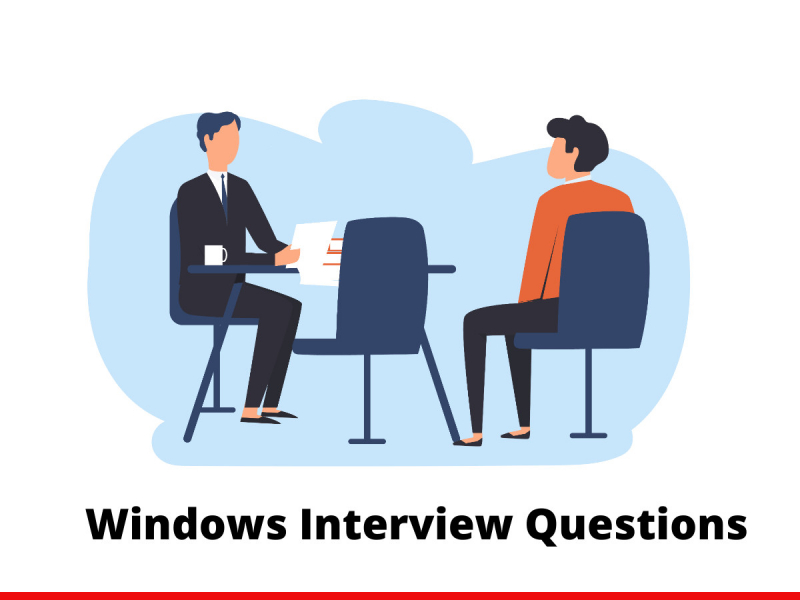Practice Windows Interview Questions and Answers.
Practice Best Windows Interview Questions and Answers for the best preparation of the Windows Interviews. Apart from this, you can also download here Windows Interview Questions PDF, completely free.

Practice Best Windows Interview Questions and Answers for the best preparation of the Windows Interviews. Apart from this, you can also download here Windows Interview Questions PDF, completely free.
Below are the list of Best Windows Interview Questions and Answers
Microsoft Windows is a proprietary graphical based operating system developed by Microsoft. First released in 1985, Microsoft Windows acts as a shell for MS-DOS that provides GUI for the users to interact with the software. Windows runs on multiple platforms such as x86-64, ARM, ARM64, and IA-32. Mainly targeted for desktop/laptop’s, Windows also has versions that run on tablets, smartphones, virtual devices, Xbox game consoles, and embedded devices. From the time of its release, Microsoft Windows has been the most popular desktop operating system with over 90 percent of the market share.
Microsoft Windows is written in C++, JavaScript, C#, and Visual Basic.
NTFS (New Technology File System) is the primary file system used in Windows operating system that supports larger file sizes and hard drives. It is the newest file system created by Microsoft and is the default for almost every modern hard drive, and SSDs. It has support for file compression, long file names, and no reasonable file size limitations.
FAT (File Allocation Table) is an older type of file system that is universally supported by all operating systems. It is normally pre-installed on all the USB drives and has a big limitation of supporting only file size up to 4GB.
MBR (Master Boot Record) is a boot sector that holds information such as the partitions of the drive, logical partitions, etc. It also acts as a loader for the operating system as it contains the executable code. The MBR is created when you first install the windows and the partitions are created. The support for MBR was first introduced with the IBM PC DOS 2.0 in 1983 and has been used ever since.
Microsoft Windows uses Hybrid kernel type architecture. It combines the features of the monolithic kernel and microkernel architecture. The actual kernel that is used in Windows is the Windows NT (New Technology).
PowerShell is a command-line shell and scripting language that is used for task automation and configuration management framework. It helps the users to automate the tasks that manage the operating systems and processes. The PowerShell is now an open-source and cross-platform tool that is built upon the .NET Core. The commands used in the PowerShell are called as the cmdlets and it lets you manage the data stores such as the registry and certificate store, and more.
The different types of Windows Operating Systems are,
To get your IP address on Windows, go to the command prompt on your system and type "ipconfig" command. This command will list the IP address of your system among other systems.
The SYSVOL (System Volume) folder is a shared directory to store the server copy of the domain’s public files. These files must be shared for common access and replication throughout the domain. This special directory resides on the %SYSTEMROOT%\SYSVOL\sysvol path in your system.
It has several folders such as Group Policy Templates (GPTs), Scripts, and Junction Points that store different files.
The Safe mode in Windows loads a minimal user interface that has only the essential services and drivers needed for the Windows OS to function. The safe mode is there on Windows to troubleshoot problems on your system like Windows crash, etc.
There are two types of safe mode available such as the default safe mode, and safe mode with networking.
The safe mode with networking adds the necessary drivers and services in the safe mode for accessing the internet and other computers on the network. There are different ways to get into the safe mode.
Here we list the main way to go into the safe mode. First, go to the advanced startup and click the restart option. Then click the troubleshoot option and click the advanced options. In the advanced options, click the Startup Settings. Then click the restart the button and press 4 or F4 to start your PC in the safe mode.
Control Panel in Windows provides the users to view and change different system settings. You can change user settings, accessibility settings, network, sound, hardware, appearance, VPN tools, input devices, and a whole bunch of other settings in the Control Panel. The Control Panel has been with Windows since version 1.0.
Some of the new features introduced with Windows 10 are,
There are many advantages to using the Windows operating system. They are,
RTM (Release to Manufacturing) is the version of the windows that are given to the manufacturers to bundle with the future version of the hardware products. These manufacturers are released to the manufacturers before they are released to the public. The RTM version of the software is a part of the release cycle.
The different editions of the Windows 10 are,
Linux and Windows are the major desktop OS available in the market right now.
There are some major differences between them that are listed below.
Linux
Windows
Never Miss an Articles from us.